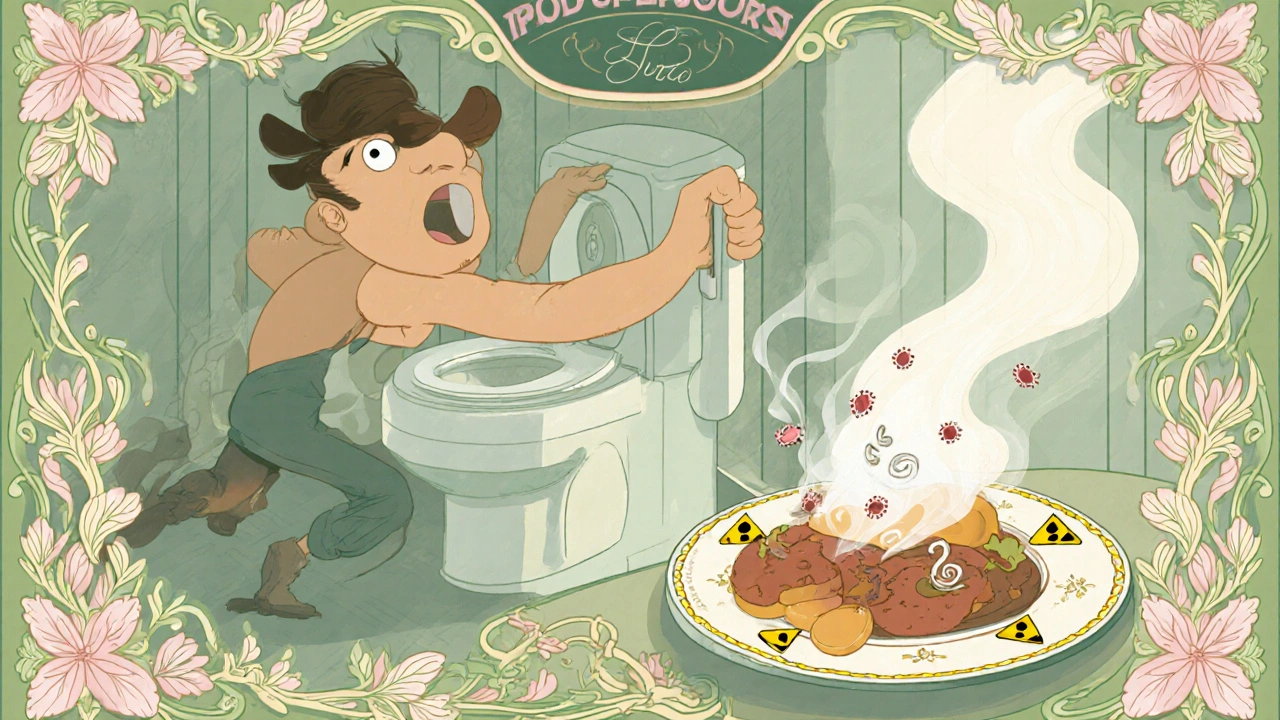When you’re hit with a sudden rush to the bathroom, you might wonder if a bad meal is to blame. The link between acute diarrhea and food poisoning is tighter than most people realize, and understanding it can help you act fast, avoid complications, and prevent future episodes.
What is acute diarrhea?
Acute Diarrhea is a rapid onset of loose, watery stools that typically lasts less than two weeks. It’s the body’s way of flushing out irritants, infections, or toxins from the gastrointestinal tract. Common symptoms include abdominal cramping, urgency, nausea, and sometimes fever.
Defining food poisoning
Food Poisoning refers to illness caused by consuming food contaminated with harmful microorganisms, toxins, or chemicals. It’s not a single disease but a collection of syndromes, each triggered by different pathogens or substances.
How the two are connected
The gastrointestinal lining reacts similarly whether it’s dealing with a virus, a bacterial invasion, or a pre‑formed toxin. When you eat contaminated food, the offending agent can irritate the gut, disrupt water absorption, and speed up intestinal motility-leading directly to acute diarrhea. In most cases, the diarrhea is the first-and sometimes only-visible sign that food poisoning is occurring.
Common culprits that cause both
Below is a quick look at the usual suspects. Each can turn a tasty meal into a night of bathroom trips.
| Agent | Type | Typical Symptoms | Incubation (hrs) |
|---|---|---|---|
| Salmonella | Gram‑negative bacteria | Watery to bloody stool, fever, cramps | 6‑48 |
| E. coli O157:H7 | Gram‑negative bacteria | Severe cramps, bloody diarrhea | 24‑72 |
| Campylobacter | Gram‑negative bacteria | Watery stool, fever, nausea | 12‑48 |
| Norovirus | RNA virus | Vomiting, watery diarrhea, low‑grade fever | 12‑48 |
| Staphylococcus aureus toxin | Pre‑formed toxin | Sudden vomiting, watery diarrhea | 1‑6 |
| Clostridium perfringens | Spore‑forming bacteria | Abdominal cramps, watery stool | 8‑16 |

Why does the gut react with diarrhea?
Three main mechanisms drive the watery output:
- Inflammation: Pathogens release toxins that inflame the intestinal lining, reducing its ability to absorb water.
- Osmotic load: Undigested food particles and bacterial by‑products draw water into the lumen.
- Secretory stimulation: Certain toxins (e.g., cholera toxin) force cells to pump electrolytes and water into the gut.
When any of these processes dominate, the colon can’t reclaim enough fluid, and the result is rapid, loose stools.
Identifying food poisoning as the cause
Not every bout of acute diarrhea comes from the kitchen. Still, a few clues point to food poisoning:
- Onset within a few hours to a couple of days after eating a specific meal.
- Multiple people in the same household or at the same event develop similar symptoms.
- Presence of nausea, vomiting, or fever alongside diarrhea.
- History of risky foods-raw eggs, undercooked poultry, unpasteurized dairy, or street‑vendor dishes.
If you can match these patterns, you’re likely dealing with food‑borne illness.
Immediate steps to manage acute diarrhea from food poisoning
Time is crucial, especially for preventing dehydration.
- Hydration first: Sip oral rehydration solution (ORS) or a DIY mix of 1 L water, 6 tsp sugar, and ½ tsp salt every hour.
- Dietary pause: Skip solid foods for the first 4‑6 hours; once vomiting subsides, start with bland items like toast, rice, or bananas.
- Avoid anti‑diarrheal meds unless a doctor advises; they can trap toxins inside.
- Probiotics (e.g., Lactobacillus rhamnosus) may shorten duration, but evidence is strongest for viral causes.
- Monitor for red flags: blood in stool, high fever (>38.5 °C), persistent vomiting, or signs of dehydration (dry mouth, dizziness).

When to see a healthcare professional
Most cases resolve within 48 hours, but seek help if any of the following appear:
- Diarrhea lasting longer than 3 days for adults (or 24 hours for children).
- Severe abdominal pain or swelling.
- Blood or mucus in stool.
- Signs of dehydration that don’t improve with fluids.
- Underlying health conditions (diabetes, immunosuppression, pregnancy).
Medical evaluation may include stool cultures, toxin assays, or blood work. In bacterial cases like Salmonella or E. coli, antibiotics are only prescribed when benefits outweigh risks.
Prevention: Keeping food poisoning at bay
Stopping the problem before it starts is the smartest move. Here are practical habits:
- Wash hands with soap for at least 20 seconds before handling food.
- Separate raw meat, poultry, and seafood from ready‑to‑eat items.
- Cook meats to safe internal temperatures (e.g., 75 °C for poultry).
- Refrigerate perishable foods within 2 hours; keep fridge at ≤4 °C.
- Discard foods that sit out too long, especially dairy and eggs.
- When dining out, choose establishments with good hygiene ratings.
- Stay informed about local outbreak alerts from the Australian Department of Health or the CDC.
Quick reference checklist
- Identify recent meals and shared symptoms.
- Start ORS hydration immediately.
- Avoid solid food for a few hours, then reintroduce bland items.
- Watch for red‑flag signs; seek medical help if they appear.
- Practice strict kitchen hygiene to prevent recurrence.
Frequently Asked Questions
Can I use over‑the‑counter anti‑diarrheal meds for food poisoning?
Generally, it’s not recommended. These drugs can slow gut movement and keep toxins inside, potentially worsening the infection. A doctor may advise them only after confirming a non‑toxic cause.
How long does food‑borne acute diarrhea usually last?
Most mild cases resolve within 24‑48 hours. Bacterial infections can linger up to a week, while viral forms like norovirus typically clear in 2‑3 days.
Is it safe to travel after a recent episode of acute diarrhea?
If symptoms have fully resolved and you’re staying hydrated, travel is usually fine. However, avoid high‑risk foods and keep ORS handy for the first 24 hours.
What’s the difference between food poisoning and a food allergy?
Food poisoning is caused by harmful microbes or toxins and often includes fever and diarrhea. A food allergy triggers the immune system, leading to hives, swelling, or anaphylaxis, usually without fever.
Can probiotics prevent food‑borne diarrhea?
Evidence shows probiotics can shorten the course of viral gastroenteritis, but they do not replace proper food safety. They’re a helpful adjunct, not a cure.
Understanding the relationship between acute diarrhea and food poisoning turns a scary night of the bathroom into a manageable health event. By recognizing the signs, acting quickly with hydration, and keeping your kitchen clean, you can minimize the impact and get back to feeling normal faster.


14 Comments
It is prudent to commence rehydration immediately, for water loss expedites physiological decline. Moreover, recognizing the incubation period of common pathogens can dramatically curtail unnecessary anxiety.
Indeed, a brief pause from solid foods before reintroducing bland items helps the gut recover effectively. Hydration solutions such as the described ORS mixture are straightforward to prepare at home.
Frankly, most laypeople overlook the critical distinction between toxin-mediated and invasive bacterial diarrheas, leading to misguided self‑treatment. The article glosses over this nuance, yet it is pivotal when deciding on anti‑diarrheal usage. Additionally, the recommended 1 L water‑sugar‑salt solution disregards electrolyte balance for pediatric cases. A more comprehensive guide would delineate age‑specific rehydration protocols.
I agree the checklist is useful and the steps are clear enough for anyone to follow
While the information is accurate, one must consider, for instance, the variability in toxin production among Staphylococcus aureus strains, which can influence the rapidity of symptom onset, and consequently, the appropriate timing of fluid replacement; furthermore, the omission of a disclaimer regarding the potential for antibiotic resistance in Salmonella infections, albeit rare, warrants a cautious approach.
Yo, just a heads‑up: if you keep the fridge at 4°C and throw out food that's been out for over two hours, you’ll dodge most of those nasty bugs that cause the quick‑flush diarrhea.
Stay hydrated and you’ll be back on your feet in no time!
But remember, the big food conglomerates often hide the real culprits behind “natural” labels, so even a simple broth could be laced with hidden toxins engineered to keep us dependent on their “cure‑all” supplements.
Oh sure, because drinking a homemade sugar‑salt concoction is the pinnacle of medical science-who needs doctors when you’ve got kitchen chemistry?
Give it time the gut will settle but keep an eye for blood or fever it’s key to know when to call a doc
Acute diarrhea, while often dismissed as a trivial inconvenience, actually serves as a critical alarm system that the gastrointestinal tract employs to expel harmful agents. The underlying mechanisms-whether inflammatory, osmotic, or secretory-are each distinct pathways that converge on a common endpoint: rapid fluid loss. When a pathogen such as Salmonella invades, it releases endotoxins that trigger a cascade of cytokines, leading to inflammation and compromised water absorption. Conversely, pre‑formed toxins like those from Staphylococcus aureus act directly on enterocytes, forcing them to secrete electrolytes and water regardless of infection. This distinction matters because anti‑diarrheal medications that slow motility can be beneficial in secretory cases but disastrous in invasive bacterial infections where they may trap toxins. Moreover, the incubation periods listed in the article provide a valuable timeline: a symptom onset within a few hours strongly suggests a toxin, whereas a 24‑hour delay points toward bacterial replication. Hydration, therefore, must be tailored; oral rehydration solutions supply not just water but essential sodium and glucose to facilitate absorption via the sodium‑glucose cotransporter. For children, the WHO’s low‑osmolar ORS formula is particularly effective and reduces the risk of hyponatremia. Nutritional management also plays a role-starting with the BRAT diet (bananas, rice, applesauce, toast) helps limit osmotic load while providing gentle calories. In addition, probiotic strains such as Lactobacillus rhamnosus have demonstrated modest reductions in viral gastroenteritis duration, though they are not a substitute for proper food safety. Speaking of safety, cross‑contamination prevention, like using separate cutting boards for raw meat and vegetables, eliminates a major transmission vector. Temperature control is equally vital; cooking poultry to an internal temperature of 75 °C ensures bacterial kill, while rapid cooling of leftovers to below 4 °C within two hours curtails bacterial growth. Public health surveillance, often overlooked by individuals, plays a crucial role in identifying outbreak clusters and issuing recalls before widespread exposure occurs. Finally, clinicians should consider stool culture or PCR testing in cases persisting beyond 48 hours or presenting with blood, as targeted antimicrobial therapy may be warranted. In summary, understanding the nuanced interplay between pathogen type, host response, and supportive care transforms acute diarrhea from a mere inconvenience into a manageable and preventable condition.
The relentless flow of water through our bodies, mirrored by the ceaseless tide of information, reminds us that neglecting the subtle signals can lead to a cascade of unforeseen consequences.
Look, the “official” guidelines are just a smokescreen; they want us to trust big pharma’s OTC meds while they hide the real cure inside the “secret” water filtration systems they don’t want us to buy.
While your theory is... actually, the article already covers the basics, so no need for extra drama.